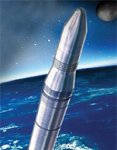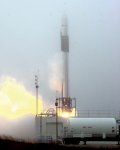SpaceX FalconNew entrants in the domestic launch industry have the potential to lower costs, and increase reliability. Some relatively new companies are beginning to produce new launch vehicles for the commercial sector and for government. One such company, SpaceX, has said that its goal is to reduce the cost and increase the reliability of launching payloads into space by a factor of ten. Space X was founded by Internet entrepreneur Elon Musk, co-founder of the popular electronic payment system PayPal. Prices are estimated at $6.7 million for the launch of the Falcon I and $78 million for the largest Falcon 9.

Space Exploration Technologies of El Segundo is one potential quick reaction launch provider. Elon Musk that is developing a small satellite launcher dubbed Falcon. The Falcon launch vehicle family is designed to provide breakthrough advances in reliability, cost, flight environment and time to launch. The primary design driver is and will remain reliability. SpacEx recognizes that nothing is more important than getting customer’s spacecraft safely to its intended destination. The company aims to reduce the cost of putting payloads into space while increasing reliability. While normal light payloads cost about $24M [by one estimate], SpaceX wants to deliver a $6M business model for small to medium payloads. The contractor is developing a family of launch vehicles intended to reduce cost and increase reliability of access to space ultimately by a factor of 10.
DoD awarded SpaceX a contract to launch a research satellite for around March 2004 on its new Falcon I rocket.
NASA
has been unwilling to consider making an award to SpaceX, saying that NASA will only launch on types of rockets that have already had at least one successful launch. The company’s long-term goals are to launch four or five times a year with its Falcon 1 rocket.
Falcon I is a mostly reusable, two-stage, liquid oxygen and rocket-grade kerosene-powered launch vehicle. The two-stage liquid-fuelled rocket booster has a re-usable first stage that is recovered from the sea after use and can be prepared for the next launch within one month. First launch of Falcon I was contracted for early 2004, carrying a US
Defense Department
communications satellite. SpaceX also had agreements in principle to perform two other Falcon I launches in the late 2004 to early 2005 timeframe.
In September 2004, SpaceX was one of four companies to receive a contract from DARPA and the USAF to demonstrate low-cost, highly responsive launch technology. Under this contract, SpaceX is to demonstrate the ability to reduce on-pad processing time by 50 percent compared to the standard Falcon 1 launcher. SpaceX is competing with three other companies;
Lockheed Martin
, Air Launch and Microcosm under the second phase of a DARPA contract. The winner will be chosen to proceed with production of a low-cost, responsive launch vehicle.

A successful ground test of the Falcon I launch vehicle at Vandenberg 27 May 2005 put the Air Force one step closer toward its goal of acquiring a less expensive means for lifting payloads into space. The full launch wet dress rehearsal marked the completion of the largest milestone remaining before launch. The test run included a countdown sequence and ignition of the main engine. It exercised Falcon vehicle systems and range safety interfaces to ensure optimal operations during the upcoming launch campaign
SpaceX broke ground on a launch pad on Omelek Island in early April 2005. In conjunction with the project, the company set up office and warehouse space on Kwajalein. Construction of the launch site on Omelek Island by Kwajalein Range Services was completed in June 2005. The first SpaceX launch from Omelek was scheduled for the summer of 2005. SpaceX had evolved from a blank sheet of paper to a fully qualified two-stage rocket with the capability of launching 1,300 pounds to low-earth orbit, about 500 miles up.
The first launch of Falcon I ended in failure 24 March 2006 over the
Pacific Ocean
shortly after liftoff. Space enthusiasts watched the launch through a live Internet telecast, but moments later the picture went dead, and the company later said it lost the space vehicle. A spokeswoman said it was not initially clear what went wrong. Falcon I’s maiden flight, conducted two years later than originally planned, carried the
Defense Department’s TacSat-1 satellite. This was the first of three scheduled Falcon I launches for the Space and Missile Systems Center at Los Angeles AFB.
The second launch attempt with a two-stage Falcon 1 rocket from its Pacific island launch site began at 9:10 p.m. EDT (0110 GMT) on 21 March 2007, but suffered a roll control malfunction 186 miles (300 kilometers) above Earth before completing its flight plan.
On 02 August 2008 the third SpaceX launch attempt failed when the first stage failed to separate after having initially performed flawlessly. The Falcon carried three small satellites: Trailblazer, a Department of Defense quick-turnaround demonstration; NASA's PRESat, a small automated laboratory, and NanoSail-D, a NASA solar sail test.
Subsequently, Elon Musk, founder of SpaceX, stated that a fourth launch was "almost ready for flight." Musk stated that "the fourth flight, currently scheduled to take place in the fourth quarter of the year, and fifth flights are being prepared, and that he has given the go-ahead 'to begin fabrication of flight 6.'" The following day, a company spokesperson also stated "that The Founders Fund, a private-equity group, has now agreed to invest $20 million in return for a relatively small minority stake." According to the company, "If the rocket's technical problems persist, [NASA's] carefully calibrated plans" to deliver cargo to the International Space Station "could fall apart, prompting
Congress
and government space officials to re-evaluate SpaceX's ability to play a major role in achieving those goals."
Falcon VIn January 2004 Space Exploration Technologies Corporation (SpaceX) announced the details of a substantial upgrade to its Falcon rocket family under development and scheduled for completion in 2005. Drawing from experience with the single engine Falcon I, at that time due to launch in mid 2004, SpaceX is developing a five engine version that will be the first American rocket with true engine out reliability in three decades. The Falcon V significantly increases the capability of the Falcon family, with a capacity of over 9,200 pounds to low orbit and up to a 13.1 foot (4 meter) diameter payload fairing.
The larger Falcon 5 uses five SpaceX-developed Merlin engines in the first stage with an engine-out capability to enhance reliability. The second stage will use one Merlin engine, instead of two Kestrel engines as previously planned.
The first Falcon 5 launch was expected in mid 2006 [previously targeted for mid 2005] from VAFB. For subsequent Falcon 5 flights, SpaceX was developing the Merlin 2 engine that is expected to enable greater lift capacity, up to 6,020 kilograms (13,274 pounds) to LEO.
On 18 August 2006 NASA selected SpaceX, El Segundo, Calif. and Rocketplane-Kistler, Oklahoma City, to develop and demonstrate commercial orbital transportation services that could open new markets and pave the way for contracts to launch and deliver crew and cargo to the International Space Station. NASA and the two companies signed Space Act Agreements that establish milestones and objective criteria to assess their progress throughout Phase 1 of the competition. Once a capability is demonstrated, NASA plans to purchase crew and cargo delivery services competitively in Phase 2. “These companies were selected from a total of 20 applicants, based on solid engineering of innovative concepts and sound business plans,” said Alan Lindenmoyer, manager of the Commercial Crew and Cargo Program Office at the Johnson Space Center, Houston.
Falcon 9Space Exploration Technologies Corp. (SpaceX) conducted the first nine engine firing of its Falcon 9 launch vehicle at its Texas Test Facility outside McGregor on 31 July 2008. A second firing on 01 August 2008 completed a major NASA Commercial Orbital Transportation Services (COTS) milestone almost two months early. At full power, the nine engines consumed 3,200 lbs of fuel and liquid oxygen per second, and generated almost 850,000 pounds of thrust. The Falcon 9 will launch SpaceX's spaceship Dragon with up to 7 humans from 2009 on.


 FALCON9 SpaceX בקייפ הועבר לכן השיגור
FALCON9 SpaceX בקייפ הועבר לכן השיגור
 אינדקס
אינדקס




